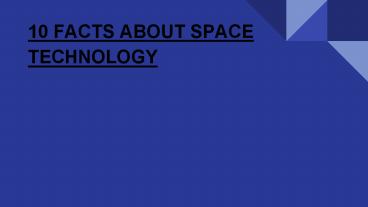10 FACTS ABOUT SPACE TECHNOLOGY - PowerPoint PPT Presentation
Title:
10 FACTS ABOUT SPACE TECHNOLOGY
Description:
Technology Moon is a site for tech enthusiasts and if you think you can provide valuable knowledge, tips and tricks, hacks for your fellow tech enthusiasts, then feel free to reach out to us. We believe that no piece of advice is completely useless and therefore, believe in giving every writer a chance that they deserve. From product reviews (such as the latest gadget) or solving technical queries (such as how to run a GUI on a remote on remote Ubuntu server), we cover all sorts of topics on our blog. – PowerPoint PPT presentation
Number of Views:324
Title: 10 FACTS ABOUT SPACE TECHNOLOGY
1
10 FACTS ABOUT SPACE TECHNOLOGY
2
INTRODUCTION
- Space technology is a technology that is
developed by space science. - Space technology includes the following
spacecraft, satellites, space stations, and
support infrastructure, equipment, and
procedures. Space is a novel environment that
attempts the work in it and it also requires new
tools and techniques. - The following are the different tools such as
satellites, space shuttles, and telescopes which
used to explore the Satellites take photos of
certain objects in depending on the mission.
Obviously, space shuttles contain humans that are
sent on a mission to explore a certain object in
space.
3
Space is completely silent.
- Space is silent because there is no medium or any
type of way through which sound is exchanged. - Space is completely silent, Astronauts use radios
to stay in communication while they were in
space, since the waves of radio can still be sent
and received.
4
The hottest planet in our solar system.
- Venus is the hottest planet in our solar system
which has an average surface temperature of
around 450 C..Interestingly, venus is not the
closest planet to the Sun. - But the mercury is closer to it but because
Mercury has no atmosphere to regulate temperature
it has a very large temperature fluctuation.
5
There may be life on Mars.
- From all the planets in our solar system (except
the Earth), Mars is one of the most likely to be
hospitable to our life. In 1986, NASA found what
they thought may be fossils of microscopic living
things in a rock recovered from Mars.
6
Nobody knows how many stars are in space.
- The size of space makes it impossible to
accurately predict the number how many stars are
there. Right now, scientists and astronomers use
the number of stars within our galaxy, There are
various ways to estimate. The number is between
200 to 400 billion stars and there are estimated
to be billions of galaxies so the stars in space
really are completely uncountable.
7
Halleys Comet wont past orbit Earth again until
2061.
- It was discovered in 1705 by Edmond Halley, the
famous comet was last seen in 1986 and it was
only seen once every 75 to 76 years.
8
A full NASA space suit costs 12,000,000.
- While the entire suit costs of it are cool 12m,
and 70 of that cost is for the backpack and
control module.
9
Neutron stars can spin 600 times per second.
- Neutron stars are the densest and tiniest stars
in the whole known universe and although that
they only have a radius of about 10 km, they may
have a mass of a few times that of the sun. They
can rotate that up to 60 times per second after
they are born from a core-collapse supernova star
explosion and have been known to spin as fast as
600-712 times per second because of their
physics.
10
The footprints on the Moon will be there for 100
million years.
- The Moon has no atmosphere, which means there is
no wind to erode on the surface and no water to
wash the footprints away. - This means that the footprints of the Apollo
astronauts, along with the spacecraft prints are
rover-prints and discarded material, which will
be there for millions of years.
11
One day on Venus is longer than one year.
- Venus has a slow axis rotation which takes 243
Earth days to complete the 1-day rotation. The
orbit of Venus around the Sun is 225 Earth days,
making a year on Venus 18 days less than that of
a day on Venus.
12
There is floating in the water in the space.
- Astronomers have found that a massive water vapor
cloud that holds 140 trillion times the mass of
water in the Earths oceans and somewhere around
the 10 billions of light-years away for making it
the largest discovery of water ever found.
13
CONCLUSION
- Tools such as satellites, space shuttles, and
telescopes are used to explore the space of space
technology. Satellites take photos of certain
objects in the space depending on the mission.
Obviously, the space shuttles contain the humans
that are sent on a mission to explore a certain
object in space. Telescopes are used from Earth
in space technology.
- Regards,
- TECHNOLOGY MOON
14
THANKYOU




























![National Institute of Technology - [NITKKR], Kurukshetra PowerPoint PPT Presentation](https://s3.amazonaws.com/images.powershow.com/9683358.th0.jpg?_=20211114015)


